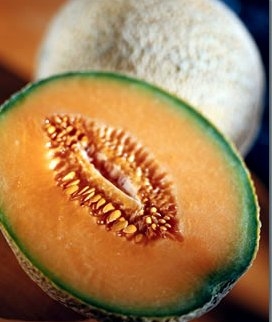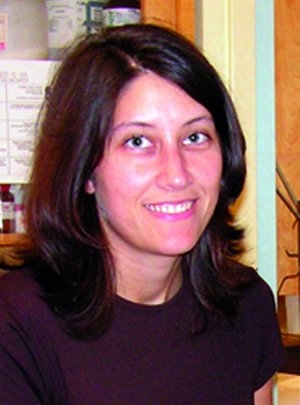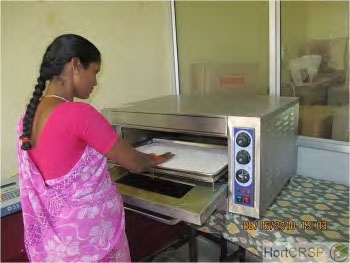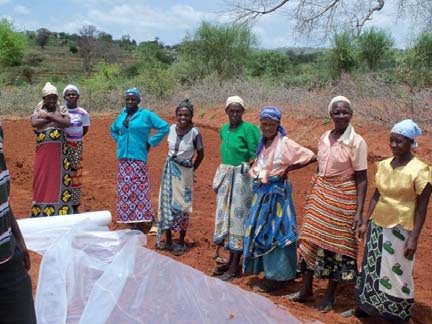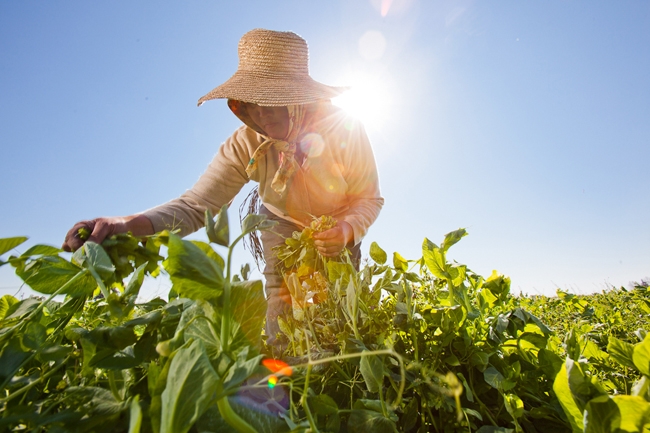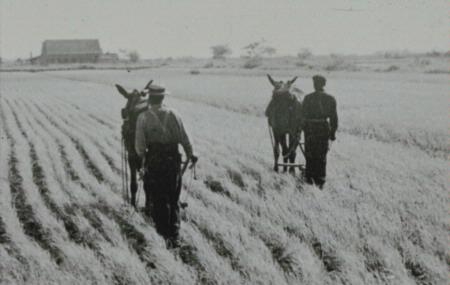UC Food and Agriculture Blogs
Unripe cantaloupe? Could be, the electronic nose knows
You know how it works: You stand in the grocery aisle, surreptitiously sniffing the cantaloupes, hoping your nose will lead you to a nice, ripe selection. But when you slice it open in your kitchen, it’s just not as ripe as you had hoped. Lucky for you (and me), UC Davis Department of Plant Sciences Assistant Professor Florence Negre-Zakharov and her team may have found a way to make imperfectly ripe fruit a thing of the past.
"We are involved in a project geared towards developing rapid methods to evaluate ripeness and flavor of fruits," explained Negre-Zakharov, who authored a paper on the method published in the March 30 edition of the Journal of Visualized Experiments (JoVE). "We evaluated an electronic nose to see if it can differentiate maturity of fruit, specifically melons. The goal is to develop a tool that can be used post-harvest to better evaluate produce, and develop better breeds."
When fruit ripens, it develops a characteristic volatile blend, indicating its maturity. Traditionally, the gold-standard of evaluating these volatiles has been gas chromatography, but it takes up to an hour to analyze a single sample, which makes it impractical to use outside the lab. Negre-Zakharov’s team wanted to determine if the much cruder — but much faster — electronic nose was able to determine if the melon they used in the experiment were ripe. It was.
"It’s quite encouraging technology for the purposes of determining maturity," she said.
"It's very impressive that the electronic nose system can do a type of gas chromatography in about a minute,” said JoVE science editor Zhao Chen. “Ultra-fast, indeed. Also, the sample preparation is as easy as making a smoothie at home. Such a user-friendly system could greatly help analysis efficiency in this field. Given the popularity of JoVE video-articles, I expect many researchers will know and adopt this method in their own research."
As a next step, the team is testing the electronic nose out in the field to see if it can still determine fruit maturity despite interference from all the background smells like soil and farm air. They hope to have results from those tests soon.
You can access a video of the study here.
Healthalicous cooking
Our youth deserve a future filled with promise and possibilities. A strong body and good health is the foundation on which a successful future can be built.
UC ANR’s new after-school curriculum is designed to help 9- to 12-year-olds develop good health skills that will last a lifetime. The six-week hands-on program promotes preparing and eating healthy meals as well as encouraging plenty of physical activity. Healthy eating and physical activity work together to help reduce obesity levels.
These free, downloadable lessons include:
- Let’s Make It Clean: Wash Up!
- Make It Healthy: Eat Balanced Meals
- Make It Crunchy: Go for Whole Grains!
- Make It Colorful: Choose Fruits and Veggies by Color
- Make it Delicious: Plan and Balance
- Make It Fun: Eat and Share
Addressing nutrition and poverty through horticulture
Nutrition, food security and sufficient family incomes are challenges in many parts of the world. Half the world’s people live in rural areas in developing countries. Because hunger and malnutrition are often linked to poverty, providing economic opportunities through horticultural production not only helps family incomes, but also addresses food security and nutrition. Training women to produce and market horticultural crops in the developing world also helps provide a much-needed income stream for families with children.
UC Davis is addressing food security and economic development in Africa, Southeast Asia, Central America, and elsewhere, by coordinating an international horticulture program. The Horticulture Collaborative Research Support Program (Hort CRSP; pronounced "hort crisp") is one of 10 CRSP programs that focus on global food production and solving food and nutrition problems in developing countries. UC Davis leads the Hort CRSP, with funding support from the U.S. Agency for International Development (USAID).
Examples of projects conducted by researchers and educators throughout the world include:
- Inexpensive cold storage systems in rural, developing areas to prolong food longevity; see page 2
- Concentrated solar drying of fruits and vegetables in East Africa; see page 3
- Improving safety and quality of tomatoes in Nigeria; see page 3
- Smallholder flower production in Honduras for export markets; see page 3
The overarching goals of the Hort CRSP are to reduce poverty and improve nutrition and health of the rural poor, while improving the profitability and sustainability of horticulture in the developing world. Priorities in the Hort CRSP include gender equity, sustainable crop production, postharvest technology, food safety, market access, and financing. The program awards research funding in the U.S. and abroad to:
- Realize opportunities for horticultural development
- Improve food security
- Improve nutrition and human health
- Provide opportunities for income diversification
- Advance economic and social conditions of the rural poor, particularly women
Dr. Elizabeth Mitcham, UC Cooperative Extension specialist in the Department of Plant Sciences at UC Davis and director of the Hort CRSP, notes, “By harnessing the research, training, and outreach expertise of the land-grant universities in the U.S. to work with partners in developing countries, we can improve horticultural capabilities in much the same way that the land-grant system helped revolutionize American agriculture.”
In the three years since the program’s inception, several projects have been completed, and many are ongoing. The program’s website offers a plethora of information, along with newsletters that highlight individual projects.
The program also has a YouTube channel, with videos on Hort CRSP projects. Some of the videos are about projects that are especially important in developing countries, including:
- The TRELLIS project — bringing together graduate students and in-country development organizations; YouTube link
- Using cell phones to give real-time information to growers in rural areas of India; YouTube link
- Inexpensive cultivation practices for smallholder farmers; YouTube link
- Indigenous products increase incomes in Ghana; YouTube link
- Saving indigenous crop seeds in Southeast Asia for resource-poor farmers; YouTube link
UC Davis, ranked first in the U.S. on research related to agriculture, food science and nutrition, and plant and animal science, is positioned to serve global needs related to food and nutrition. Of the 10 CRSP programs administered by USAID, two of the programs are based at UC Davis — the Hort CRSP program, and the BASIS CRSP, which was highlighted in a recent Food Blog post and addresses financial issues related to agricultural productivity.
Cultivating California
Only in California could arid land be converted into the nation’s salad bowl.
In the late 1800s, University of California researchers discovered how to remove salts from the soils of the Central Valley, turning it into one of the most productive agricultural regions.
UC researchers continue to play a key role in agriculture today, keeping California the nation’s leading agricultural state, from dairies in Tulare to nut farms in Newberry Springs.
A new brochure highlights the breadth of UC Agriculture and Natural Resources’ impact. UC guidelines have helped farmers boost broccoli production. UC scientists have developed sweet-tasting citrus and strawberries to meet consumer demands. UC certifies more than 95 percent of wine grapevines grown in the state, providing a reliable supply of high-quality vines for California’s multibillion-dollar wine industry. Whether it’s managing invasive pests, promoting nutrition or sustaining small farmers, ANR serves California’s communities with a focus on advising, educating and searching for solutions.
For more information, read the Cultivating California brochure.

uc anr minibrochure cover s2
Were those the days?
To the tune of Mary Hopkin's iconic 60s hit, Those Were the Days, a team of UC animal scientists ask whether those bygone times people remember nostalgically would be up to the challenge of feeding the world today.
"People have a romantic image of farming in the past," said Alison Van Eenennaam, UC Cooperative Extension specialist in the UC Davis Department of Animal Science. "It may be remembered as bucolic, but there wasn't enough food being produced to cope with world population growth."
Van Eenennaam, an expert in animal genomics and biotechnology, rewrote the song and posed the question, Were those the days?, with historical photos of Americans hand-milking cows one by one, preparing a field with a horse-drawn plow and tossing out handfuls of chicken feed from a bucket.
Van Eenennaam's remake declares,
Those were long days, my friend
We thought they'd never end
We'd plow and toil forever and a day
It's not the life we'd choose
We'd work and never snooze
Those were hard days, oh yes, those were hard days.
Interspersed in the video are statistics that reveal how far modern agriculture has come. For example, the U.S. dairy cattle population peaked at 25.6 million animals in 1944. By 1997, improved dairy management and genetics increased milk production per cow by 370 percent, reducing by more than half the number of dairy cows needed to provide milk for U.S. consumers.
The video notes that, in 1923, it took about 112 days to produce a broiler chicken. In 2000, a much larger chicken is produced in 48 days.
"If you're going to expend resources feeding and housing a happy cow," Van Eenennaam said, "it stands to reason that feeding an efficient, high-producing cow decreases the amount of feed required and waste generated per glass of milk or pound of beef."
Van Eenennaam’s video production is competing in a contest sponsored by the American Society of Animal Science. The video that gets the most “likes” on YouTube before June 1 receives a cash prize and will be shown at the American Society of Animal Science meeting in Phoenix. See the video below, but go to YouTube and sign into your Gmail or YouTube account for your “like” to count.



